What's Happening Here?
Let's start off with one of my favorite features—that's right, it's time to play "What's Happening Here?" It's a diagnostic challenge, rated E for everyone. The rules are simple—take a look at the image below and try to figure out what's causing the symptoms you see before you finish reading the newsletter. Are you ready? Alright then, here we go.

Check out these markings on this crop of buddleia. I think this challenge may be too easy for many of the experienced subscribers; however, if I were a betting man, I'd wager that many of you may not recognize these symptoms. It's time for me to ask, "What's happening here?"
Enjoy the newsletter, I'll reveal the answer before signing off.
Farewell to Cultivate'19
It's officially over, but from what I can tell, Cultivate'19 was a huge success.
The 7+ acre trade show floor showcased products from over 650 suppliers, and even had a large area designated for new annual and perennial cultivars. There were dozens of educational sessions and even more opportunities for networking with over 10,000 of your industry peers, vendors and fellow plant nerds like myself.
If you were able to attend this event, I hope it was as prosperous as my experience was. If you weren't able to attend Cultivate'19 or perhaps have never attended, I encourage you to consider attending it next year. Mark your calendars—Cultivate'20 is being held July 11-14, 2020.
Aphid Management Resource
Dr. Raymond Cloyd of Kansas State University has done it again. What has he done, you ask? He's compiled another great resource for our industry. This time, Dr. Cloyd released an extension bulletin titled, "Aphid Management in Greenhouse Productive Systems."
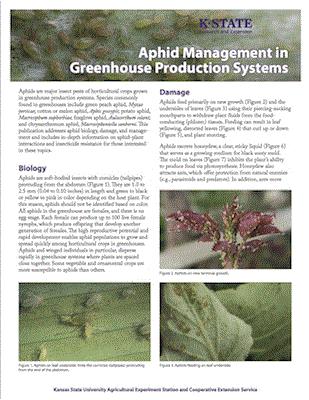
This extension bulletin from Kansas State University Research and Extension is packed full of information about aphid biology, the damage they cause and methods of controlling them with biologicals and with traditional pesticides. This reference is more heavily weighted towards the biological control options. Regardless of your preference for controlling aphids, I'm sure you'll find this FREE bulletin both useful and informative.
Click here to download your free seven page "Aphid Management" bulletin.
HydraFiber Webinar
If you're like many growers, you've heard of HydraFiber before. Or perhaps you've attended one of the previous Ball Publishing HydraFiber webinars in the past, but have you had the opportunity to learn firsthand from growers who've already trialed and implemented HydraFiber into their growing mix? If not, I can help make this happen for you.
Actually it's not me—my friends at Ball Publishing, in collaboration with HydraFiber, have put together an expert panel of growers who will each be discussing how they are using HydraFiber, sharing their reasons for switching and offering insights as to how HydraFiber has improved production efficiencies, inventory management and crop production.
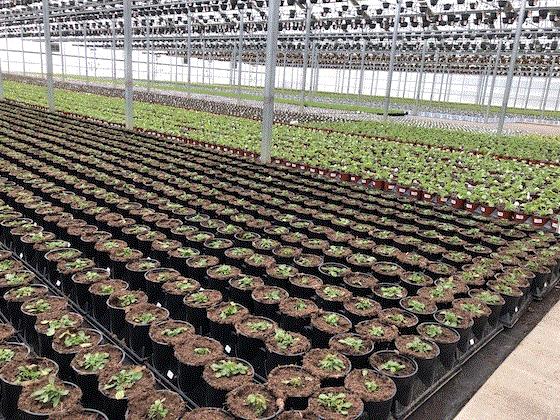
Perennials being grown in HydraFiber at Dallas Johnson Greenhouses.
The expert panelists are:
-
Scott Barnitz of Bob’s Market in Mason, West Virginia (annuals)
-
Chad Cagle of ColorPoint in Paris, Kentucky (annuals and hemp)
-
Steve Garvey, Dallas Johnson Greenhouses in Council Bluffs, Iowa (annuals and perennials)
Daniel Norden, Senior R&D and Technical Specialist Manager for Profile Products' horticulture business will also be on hand to share more examples of how this innovative technology is helping growers build an efficient and effective media program.
So, when is this great learning opportunity? I'm glad you asked—the FREE "Grower Panel: Understanding HydraFiber Advanced Substrate" webinar will be:
Date: Tuesday, July 30, 2019
Time: 1:00 PM Eastern/12:00 PM Central
Register for the webinar at www.growertalks.com/webinars.

Plug & Cutting Conference
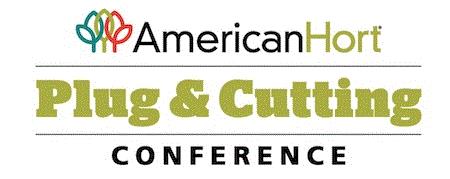
If you're looking for a great opportunity to polish up your propagation skills, I highly recommend you consider attending AmericanHort's Plug & Cutting Conference in Charlotte-Concord, North Carolina, on September 4-6, 2019. I've been to several of them in the past and find the educational content to be top-notch. The conference is a great place to learn the newest and best strategies, technologies and techniques for propagating plugs and liners. The conference will also have hands-on workshops and tours for those who would really like to dive in and see things first-hand.
Click here to learn more about AmericanHort's Plug & Cutting Conference.
The Answer Is ...
Were you able to determine what was causing the angular leaf blotches on the buddleia? Here's a refresher in case you're still pondering the possibilities.
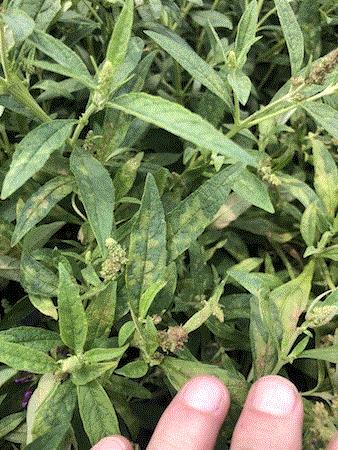
Based on the symptoms shown, if you answered foliar nematodes, your answer is close, but unfortunately it's not the correct one. If on the other hand, your response is downy mildew—your diagnostic skills are spot on; you each earned a golden star and a well-deserved pat on the back.
Downy mildew looks slightly differently on various perennials. In general, early symptoms of downy mildew appear as yellow, tan or purplish leaf splotches on the upper leaf surfaces. These spots are usually angular and are bound between the veins of the leaf. In most cases where downy mildew is present, there will be brown to white "fuzzy" sporangia on the undersides of the leaf directly opposite or under the discolored patches found on the upper leaf surfaces.
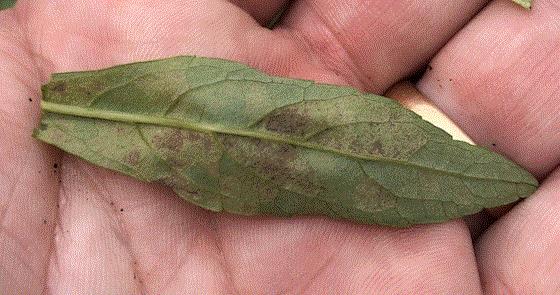
Sporangia may not be present in all cases. There was only a slight amount of sporangia observed on this buddleia (above).
Infections most commonly begin with moist conditions and high humidity. A film of water on the leaves for more than six hours is sufficient for germination and entry.
To reduce the likelihood of downy mildew infestations, maintain plants with dry leaves going into the night, increase the air circulation around the crop and irrigate early in the day to allow the leaves to dry as quickly as possible.
It's best to control downy mildew preventatively with fungicides. Some of my favorites and most effective fungicides for controlling downy mildew are Fenstop, Micora, Segovis, Stature and Subdue Maxx. There are other fungicides that work well preventatively, but this listing is the best of the best at controlling downy mildew.




Thanks for reading this edition of Perennial Pulse. Please let me know if you have any questions or article ideas for future newsletters.
My email is ppilon@ballpublishing.com.
Take care,
Paul Pilon
Editor-at-Large
Perennial Pulse
This email was received by you and over 34,190 subscribers!
If you're interested in advertising in Perennial Pulse, contact Kim Brown ASAP and she'll hook you up.